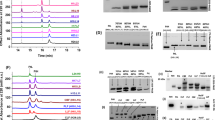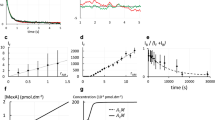Abstract
A CONTROVERSIAL question in the chemistry of the transferrins is whether the two specific sites of the proteins bind metal ions pairwise or randomly. Equilibrium dialysis studies by Aasa et al.1, in which care was taken to show that true equilibrium had been achieved, indicated that the stability constants for the sites were virtually identical; this suggested that the binding sites were equivalent and non-interacting. This work was corroborated by studies using the techniques of moving boundary electrophoresis2 and isoelectric focusing3. In each of these studies, three species of transferrin were recognized and it was suggested that these represented molecules containing nought, one or two iron atoms. This assignment has been challenged by Wood-worth et al.4, who argued that the species with intermediate electrophoretic mobility or intermediate isoelectric point was really a dimer composed of molecules devoid of iron and molecules containing two iron atoms. This alternative interpretation was taken as supporting the earlier contention of Woodworth based on kinetic studies that iron atoms bind to transferrin only pairwise, and that solutions of transferrin less than fully saturated with iron would contain only two separable species of protein molecules, those without any iron and those with two iron atoms per molecule5.
This is a preview of subscription content, access via your institution
Access options
Subscribe to this journal
Receive 51 print issues and online access
$199.00 per year
only $3.90 per issue
Buy this article
- Purchase on Springer Link
- Instant access to full article PDF
Prices may be subject to local taxes which are calculated during checkout
Similar content being viewed by others
References
Aasa, R., Malmström, B. G., Saltman, P., and Vänngård, T., Biochim. Biophys. Acta, 75, 203 (1963).
Aisen, P., Leibman, A., and Reich, H. A., J. Biol. Chem., 241, 1666 (1966).
Wenn, R. V., and Williams, J., Biochem. J., 108, 69 (1968).
Woodworth, R. C., Tan, A. T., and Virkaitis, L. R., Nature, 223, 833 (1969).
Woodworth, R. C., Proc. Colloq. Protides Biol. Fluids, 14, 37 (1967).
Yphantis, D. A., Biochemistry, 3, 297 (1964).
Koenig, S. H., and Schillinger, W., J. Biol. Chem. (in the press).
Stratil, A., Comp. Biochem. Physiol., 22, 227 (1967).
Author information
Authors and Affiliations
Rights and permissions
About this article
Cite this article
AISEN, P., KOENIG, S., SCHILLINGER, W. et al. Absence of Dimers and Nature of Iron Binding in Transferrin Solutions. Nature 226, 859–861 (1970). https://doi.org/10.1038/226859a0
Received:
Issue Date:
DOI: https://doi.org/10.1038/226859a0
Comments
By submitting a comment you agree to abide by our Terms and Community Guidelines. If you find something abusive or that does not comply with our terms or guidelines please flag it as inappropriate.



